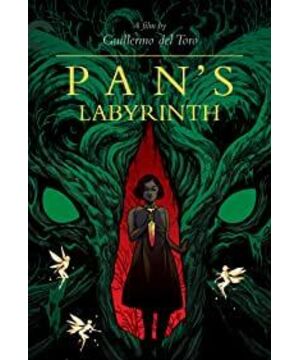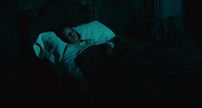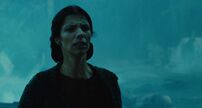This is a black magic style film, director Guillermo del Toro admitted that he was deeply influenced by the Spanish painter Goya's black series of oil paintings, so his films are always full of black and evil magic. This film is a fairy tale not suitable for children to watch, and it is a reproduction of a magical realism drama. The screen presents a bizarre situation in a magical world, set in 1944, and the fascist murder of guerrilla fighters as a real-world story, aimed at criticizing the loss and damage caused by World War II to Spain.
Today's movies are different from the past and cannot exist in a simple mode. Therefore, the pure genre film mode basically no longer exists, and there are often films that combine various elements. I think the artistic achievement of this film is that it harmoniously integrates a variety of contrasting genre film styles. The various fantasy scenes in the film are basically Del Toro paintings that are a bit like Goya, and a bit B-horror. The unique visual style of the color of the film, and the film has a fairy tale atmosphere at the same time. Fantasy and politics, fairy tales and history, fraternity and violence are blended together in the film to achieve a balanced effect, which is very rare.
Magic movies are talked about by people nowadays because they match the motif of traditional mythology. There is a saying that goes "If you can't explain the world, then create a world." Magic movies use a simple and easy-to-understand form to Explaining the world, including life, death, all things, and destiny, gives a reason to all kinds of existence, and preserves a basic reading of human nature. From behind a large number of bizarre plots and colorful characters, we can read the human desire to understand and conquer the world. It is for this reason that the ability to borrow or manipulate natural or unnatural forces has become the main feature of the protagonists in fantasy movies, which distinguishes us from real life. There are many aspects of the film that fit the magic movie. In the fantasy world, races such as humans, dwarves, and elves are the protagonists, and those ancient gods are rarely described in detail. Almost all fantasy movies describe the process of the protagonist growing up as an ordinary person, and even if he has a godhead, he will not wake up at the beginning. The adventure of Ophelia, the protagonist of the film, in the underground kingdom is like this. Under the leadership of the guiding spirit who turned into a praying mantis, she found the maze in the magical world. The half-human, half-sheep Pan told her that she was the princess of the underground kingdom. After completing three missions, you will be able to return to your homeland. However, this dream, which is also true and illusory, is also dark, and all the surreal magical passages in the film also present an evil taste. In the legend, Pan is not only the god of animal husbandry, but also a symbol of nightmares. This kind of image setting, which is both good and evil, also brings a strong evil atmosphere to the surreal passages. Pan's Labyrinth is a spooky underground cave. In other scenes, the muddy underground tunnels, the giant toad covered in mucus, and the terrifying white monster all decorate the magical world extremely terrifying. This is also echoed with the dark real world. There have always been different interpretations of the magical part of the film, and what we can conclude from the end is that the director deliberately arranged this division to let people have their own ideas. In fact, it doesn't matter if it's true or not. If it's true, it is to give the audience a psychological fulcrum, which is in line with the style of mainstream movies. Magic realism focuses on reality, and all the illusory plots in the film reflect the darkness and cruelty of reality.
What fascinates me about the film is its rich metaphors. At the beginning of the chapter, when we see the name of the heroine Ofelia, we should think of the tragic fate of its implied characters. The idea is derived from the character of the same name in Shakespeare's famous play "Hamlet". The film is also a fairy tale of revolution. Ophelia symbolizes the left wing. The director emphasized Ophelia's "left-leaning" stance at least three times. At the beginning of the film, Ophelia and her mother drive to the captain's camp. As she picks up the shard of the statue on the way and fills it up on the head of the statue, we notice that she's filling in the left eye (from O's point of view). Some commentators pointed out that the moral of this plot is to open your eyes and see the essence of the world - from now on, the little girl will be able to see the fairy world that no one has ever seen. If this explanation holds true, Ophelia is glaring at the left eye, and the essence she finds is the essence seen from the left wing's perspective. In layman's terms, she began to "see the world with her left eye".
The convoy arrives at the camp, and Ophelia meets the captain for the first time. The scene of the two shaking hands is hilarious. The little girl held a pile of fairy tales in her right hand and stretched out her left hand tremblingly. The captain as a fascist officer stretched out his right hand, grabbed her left hand, and said coldly: Es la otra mano, Ofelia. (It should be the other hand, Ofelia). When a leftist meets a rightist, of course, they part ways. A few minutes later, the little girl solemnly said to Mercedes in the maze: The captain is not my father. Steadily sever any legal ties to the right-wing dictator.
Ophelia goes to Pale Man's underground palace to perform the second task given to her by Pan. There are three small doors on the wall. According to the instructions of the elves, she should open the door in the middle. The little girl hesitated, opened the door on the left, and took out a shiny short sword. The gods pointed out the middle way, but the little girl once again insisted on her leftist position.
The next episode is very interesting. After Ophelia gets the dagger, according to the elf's gesture, she should kill the pale man whose hands are covered with human blood (in the context of this film, it is not difficult for us to regard him as a symbol of the fascist tyrant) . At this time, the little girl who had always been calm and undisturbed suddenly seemed to be a different person. She seemed to have forgotten her mission. She was attracted by the feast on the table and picked grapes to eat. In Western culture, grapes, like apples, are often compared to temptations. In many novels and movies, people die because they are tempted by grapes! Secondly, the grapes are associated with the god Pan in the legend, implying the death of Yin Dan. Ophelia's "compromise" and "regression" at critical moments implied the director's satire on the left.
There is a kind of understanding, throughout the course of Ophelia’s actions, from the enlightenment of thought (filling eyes), to revolutionary actions (finding keys, taking daggers), to bloodshed (death), building a new society (fighting for babies), Finally realizing the ideal kingdom (returning to her hometown), Ophelia has almost completed a complete revolution in her magical and real worlds. That makes perfect sense.
This is a very rich film, with various symbols intertwined. On the surface it seems to be just a slightly gloomy fairy tale, but if you analyze it carefully, you will feel the painstaking efforts of the director. Almost every shot, every picture has ulterior motives. And the imagination space left to the audience is also very broad, so there are many different understandings after watching it. It is intended to be realistic, but it contains a fairy tale-like meaning that transcends reality. For the torture of human nature, truth and goodness, beauty and ugliness, war and peace, cowardice and bravery, life and blood, in the ugly and cruel reality, the struggle is so weak and weak that it takes life to defend the last trace of human conscience . In two co-existing worlds, on the one hand, the truth, the good and the beautiful are recognized and respected after experiencing hardships, while on the other hand, they are tyrannical and unlovable. That's what makes magic realism so appealing.
View more about Pan's Labyrinth reviews











